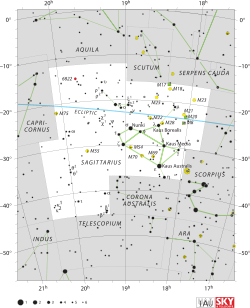Phi Sagittarii

Location of φ Sagittarii (circled) | |
| Observation data Epoch J2000 Equinox J2000 | |
|---|---|
| Constellation | Sagittarius |
| Right ascension | 18h 45m 39.38610s[1] |
| Declination | –26° 59′ 26.7944″[1] |
| Apparent magnitude (V) | 3.17[2] |
| Characteristics | |
| Spectral type | B8.5 III[3] to B7 IV[4] |
| U−B color index | –0.36[5] |
| B−V color index | –0.11[5] |
| Astrometry | |
| Radial velocity (Rv) | +21.5[2] km/s |
| Proper motion (μ) | RA: +50.61[1] mas/yr Dec.: +1.22[1] mas/yr |
| Parallax (π) | 13.63 ± 0.19[1] mas |
| Distance | 239 ± 3 ly (73 ± 1 pc) |
| Details | |
| Mass | 4–4.2[6] M☉ |
| Radius | 4.8[6] R☉ |
| Luminosity | 475[6] L☉ |
| Temperature | 14,990[4] K |
| Rotational velocity (v sin i) | 35[7] km/s |
| Age | 1.65 × 108[6] years |
| Other designations | |
Phi Sagittarii (Phi Sgr, φ Sagittarii, φ Sgr) is a star in the southern constellation of Sagittarius. With an apparent visual magnitude of 3.17,[2] it is the ninth brightest star in the constellation and is readily visible to the naked eye. Parallax measurements place it at a distance of roughly 239 light-years (73 pc) from the Earth.[1]
The stellar classification of this star has been rated at B8.5 III[3] and B7 IV,[4] with a luminosity class of III indicating it is a giant star, while a class of IV suggests it is still a subgiant star. Both represent stages in the evolution of a star after it has exhausted the hydrogen at its core. This energy is being radiated from the star's outer envelope at an effective temperature of 14,990 K,[4] which produces the blue-white hue typical of B-type stars.[9]
In the past, this star catalogued as a spectroscopic binary and a companion was apparently detected through lunar occultation.[10] However, it is most likely a solitary star[6][11] and any nearby stars are merely optical companions.
Name and etymology
- This star, together with :
- γ Sgr, δ Sgr, ε Sgr, ζ Sgr, λ Sgr, σ Sgr and τ Sgr consisting the asterism Teapot.[12][13]
- σ Sgr, ζ Sgr, χ Sgr and τ Sgr were Al Naʽām al Ṣādirah (النعم السادرة), the Returning Ostriches.[14] According to the catalogue of stars in the Technical Memorandum 33-507 - A Reduced Star Catalog Containing 537 Named Stars, Al Naʽām al Ṣādirah or Namalsadirah was originally the title for four stars: φ Sgr as Namalsadirah I, τ Sgr as Namalsadirah II, χ1 Sgr as Namalsadirah III and χ2 Sgr as Namalsadirah IV (except σ Sgr and ζ Sgr) .[15]
- In Chinese, 斗 (Dǒu), meaning Dipper, refers to an asterism consisting of φ Sagittarii, λ Sagittarii, μ Sagittarii, σ Sagittarii, τ Sagittarii and ζ Sagittarii. Consequently, φ Sagittarii itself is known as 斗宿一 (Dǒu Sù yī, English: the First Star of Dipper.)[16]
References
- ↑ 1.0 1.1 1.2 1.3 1.4 1.5 van Leeuwen, F. (November 2007), "Validation of the new Hipparcos reduction", Astronomy and Astrophysics 474 (2): 653–664, arXiv:0708.1752, Bibcode:2007A&A...474..653V, doi:10.1051/0004-6361:20078357
- ↑ 2.0 2.1 2.2 Wielen, R. et al. (1999), Sixth Catalogue of Fundamental Stars (FK6). Part I. Basic fundamental stars with direct solutions (35), Astronomisches Rechen-Institut Heidelberg, Bibcode:1999VeARI..35....1W
- ↑ 3.0 3.1 Houk, Nancy (1979), Michigan catalogue of two-dimensional spectral types for the HD stars 3, Ann Arbor, Michigan: Dept. of Astronomy, University of Michigan, Bibcode:1982MSS...C03....0H
- ↑ 4.0 4.1 4.2 4.3 Zorec, J. et al. (July 2009), "Fundamental parameters of B supergiants from the BCD system. I. Calibration of the (λ_1, D) parameters into Teff", Astronomy and Astrophysics 501 (1): 297–320, Bibcode:2009A&A...501..297Z, doi:10.1051/0004-6361/200811147
- ↑ 5.0 5.1 Johnson, H. L. et al. (1966), "UBVRIJKL photometry of the bright stars", Communications of the Lunar and Planetary Laboratory 4 (99), Bibcode:1966CoLPL...4...99J
- ↑ 6.0 6.1 6.2 6.3 6.4 Kaler, James B., "PHI SGR (Phi Sagittarii)", Stars (University of Illinois), retrieved 2012-01-15
- ↑ Abt, Helmut A.; Levato, Hugo; Grosso, Monica (July 2002), "Rotational Velocities of B Stars", The Astrophysical Journal 573 (1): 359–365, Bibcode:2002ApJ...573..359A, doi:10.1086/340590
- ↑ "phi Sgr -- Star", SIMBAD (Centre de Données astronomiques de Strasbourg), retrieved 2012-01-15
- ↑ "The Colour of Stars", Australia Telescope, Outreach and Education (Commonwealth Scientific and Industrial Research Organisation), December 21, 2004, retrieved 2012-01-16
- ↑ Finsen, W. S. (April 1951), "The duplicity of phi Sgr", Astronomical Journal 56: 56, Bibcode:1951AJ.....56Q..56F, doi:10.1086/106589
- ↑ Eggleton, P. P.; Tokovinin, A. A. (September 2008), "A catalogue of multiplicity among bright stellar systems", Monthly Notices of the Royal Astronomical Society 389 (2): 869–879, arXiv:0806.2878, Bibcode:2008MNRAS.389..869E, doi:10.1111/j.1365-2966.2008.13596.x
- ↑ "Sagittarius". deepsky.astroinfo.org. Retrieved 30 August 2008.
- ↑ skywatchers
- ↑ Allen, R. H. (1963). Star Names: Their Lore and Meaning (Reprint ed.). New York: Dover Publications Inc. p. 355. ISBN 0-486-21079-0. Retrieved 2012-09-04.
- ↑ Jack W. Rhoads - Technical Memorandum 33-507-A Reduced Star Catalog Containing 537 Named Stars, Jet Propulsion Laboratory, California Institute of Technology; November 15, 1971
- ↑ (Chinese) AEEA (Activities of Exhibition and Education in Astronomy) 天文教育資訊網 2006 年 5 月 11 日
| ||||||||||||||||||||||||||